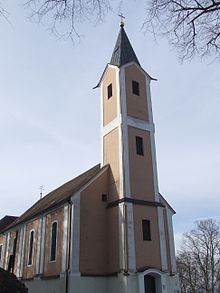Pilgrimage Church Maria Hilf (Neumarkt in der Oberpfalz)
The pilgrimage church Maria Hilf is a Catholic church and is located on the Mariahilfberg in Neumarkt in the Upper Palatinate , 586 meters above sea level. Until 2001 it was also the monastery church of the adjacent Carmelite monastery.
description
In addition to the road across the Höhenberg district, a way of the cross with 367 steps leads up to the church, on which the stations of the Passion of Jesus Christ can be traced. The exterior of the baroque church is rather simple and characteristic of the modest conditions in the Upper Palatinate , even many years after the Thirty Years' War . Inside the church, however, a delicate, fine baroque sheen unfolds . In the south, the Carmelite monastery is directly adjacent to the church. To the east, slightly higher than the church and monastery, is the former and now abandoned cemetery of the monastery, which is surrounded by a wall.
It belongs to the parish of St. John .
history
Around 1677, the superior Father Gabriel von Braunau of the newly built Capuchin monastery in Neumarkt had three crosses erected on the mountain, which was then still known as the Risselberg. In 1684, based on the model of the Church of the Holy Sepulcher in Jerusalem, a small burial chapel was built on the mountain, to which a way of the cross with many steps led. In 1687 a wooden Lady Chapel was built nearby with a copy of the famous image of the Virgin Mary by Lucas Cranach the Elder in Innsbruck . At the same time a hermit went up the mountain. The first pilgrimages started and the council of the city of Neumarkt decided to build a permanent church in the times of the Turkish threat. The flourishing of pilgrimages in nearby Freystadt may also have played a role in this . The implementation of the construction dragged on due to initial construction mishaps and lasted from 1718 to 1727. The consecration of the church took place on February 11, 1725. The tower was not completed until around 1757 and houses a three-part chime with the TeDeum motif g sharp ´-h´-cis´´ sounds.
After the Capuchins had to leave Neumarkt in 1802 as part of the secularization of Bavaria, the pilgrimage was orphaned for a long time. On September 25, 1841, lightning struck the church tower and caused serious damage. The roof of the tower burned out and the bells melted. The church itself could be saved from the fire. In 1907 the Carmelites built a monastery next to the church, which was a spiritual center for pilgrims for almost 100 years, with a short interruption during the Second World War , until 2001. In August 2001, due to the shortage of personnel in the Order and despite a collection of 13,000 signatures, the last two residents, Father Michael and Brother Tarsitius, had to leave the monastery. Since 2004 the pilgrimage church has been looked after by Polish Redemptorist Fathers . In late summer 2016, they were replaced by members of the Argentine Order Institute of the Word Incarnate .
organ
The organ was built in 1977 by the organ building company Mathis & Söhne (Näfels, Switzerland). The slider chest instrument has 14 stops on two manuals and a pedal . The playing and stop actions are mechanical. The organ is located in a historical prospectus from 1755.
|
|
|
||||||||||||||||||||||||||||||||||||||||||||||||||||||||||||||||||||||||||||||||||||||||||
- Coupling: II / I, I / P, II / P
Web links
Individual evidence
- ^ Negotiations of the Historical Association for Upper Palatinate and Regensburg, Volume 19, Regensburg 1860
- ↑ Information on the organ
Coordinates: 49 ° 16 ′ 21 ″ N , 11 ° 28 ′ 57 ″ E


